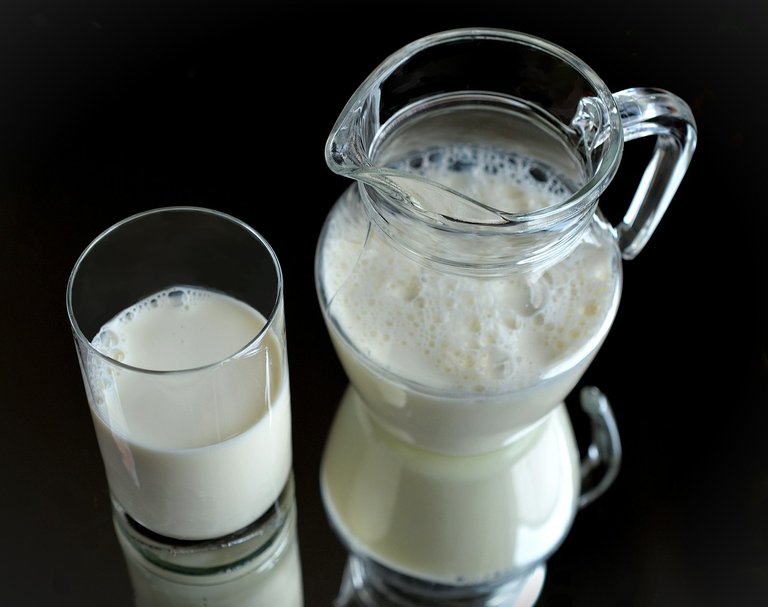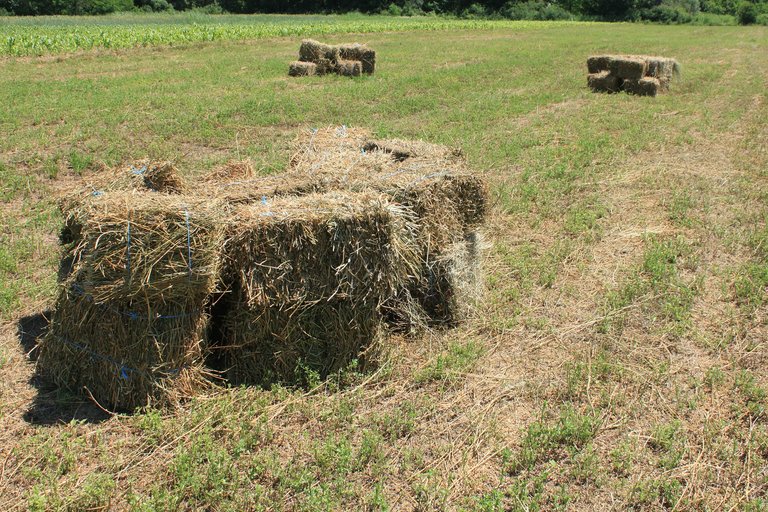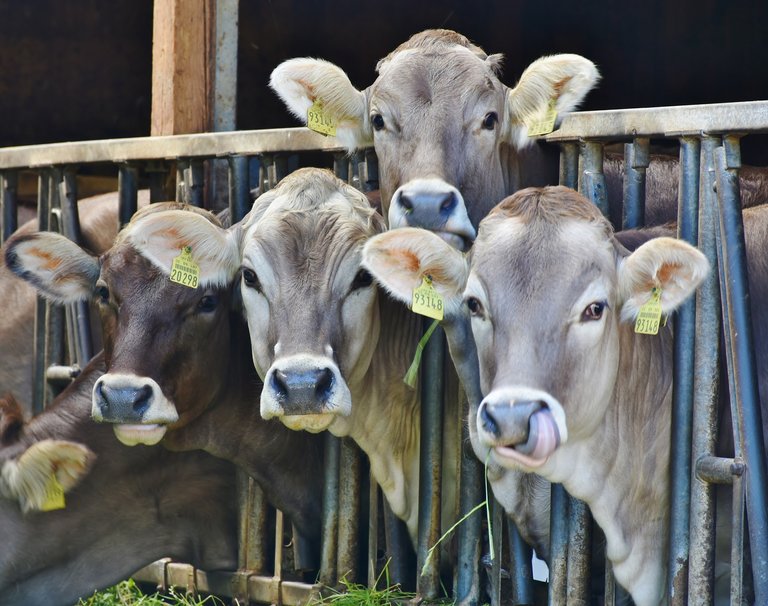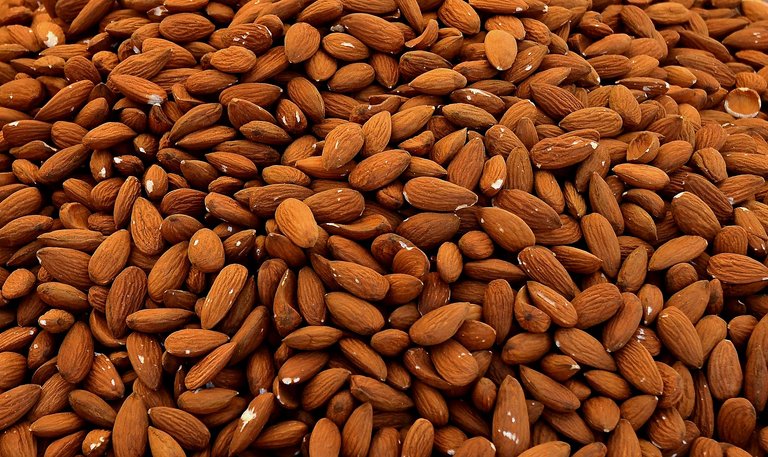
Cow Milk Vs. Almond Milk
For any scientist, it's common to feel like a news article is oversimplifying or spinning a mundane discovery into something flashy and sexy. Recently, a friend sent me a New Yorker article about different types of milk. This article had some serious issues. Let's go through it, debunk some myths, and get informed!

An article about milk, but it has some problems!
Soy and Hormones
“Soy milk… ...was for people who enjoyed having their endocrine systems disrupted, or who worked for Monsanto (Goodyear, 2015)”
Hmm. Soybeans do contain isoflavones that are a source of phytoestrogen, which in theory can act like estrogen in the body. But does this affect people’s hormone systems? No, this popular myth has been repeatedly debunked (Messina, 2010) (Hamilton-Reeves et al., 2010) (Chen et al., 2014). In fact, soy consumption is associated with a reduction of prostate cancer risk in men (Yan and Spitznagel, 2009).
It's true that Monsanto is a big producer of soybeans, and corn too (Plume, 2017). But that’s a weird point to make here, because “Around 60 percent of corn and 47 percent of soy produced in the United States is used in domestic livestock production for feed (Olson, 2006).” Goodyear inadvertently brings up an important point regarding cow milk here: what the cows are being fed. We’ll come back to this.

Almond milk takes 13% less water to make than cow milk
Almonds and Water
“almond milk is now routinely decried as one of the worst water hogs around (Goodyear, 2015)”
Even though this article is about the differences between cow and almond milk, there is no direct comparison between the two, which you’d think would be important. So let’s compare water usage ourselves, using an earlier article from the same source that the first article used: Mother Jones. Here, making almond milk is estimated to take 23 gallons of water while cow milk takes an estimated 30 gallons. This article also shows an estimate of how much water it takes to make the alfalfa that dairy cows eat (Park and Laurie, 2014).
Speaking of alfalfa, meat and dairy products accounted for 47% of California’s water footprint in 2012, “due to the amounts of water-intensive feed required to raise the animals (Fulton et al., 2012).” With 1,755,000 dairy cows as of 2017, California has the most dairy cows of any state by a wide margin of almost 500,000 (U.S. Department of Agriculture, 2017). This is important, because California has been in a drought for the past several years!

Bales of alfalfa, ready to feed cows
Cattle milk also leads to about 20% of the greenhouse gas emissions caused by all livestock globally, according to the Food and Agriculture Organization of the United Nations (Gerber et al, 2013). Almonds presumably create fewer greenhouse gasses, because they do not fart.
This article duly criticizes the practice of mono-cropping (growing only one crop on a plot of land) and the impacts of its byproducts. But then the author turns around to tell you that it’s useless to try to “climate-proof” your diet. While institutional change is more important than individual-based environmentalism (Csutora, 2012), there is power in the hands of the consumer, and to advocate for nihilism in the face of environmental decisions people make in their day to day lives is dis-empowering and wrong.
Lastly, she quotes the C.E.O. of a meat company to say that cows are appropriate to farm during a drought because they “evolved in drought prone areas (Goodyear, 2015).” Maybe we should take that with a grain of salt, considering what we just researched.

About 20% of global greenhouse gas emissions come from dairy farming
Ethics of Dairy
“...while cow milk was for gluttonous torturers (Goodyear, 2015).”
This seems like an ironic leap: is drinking milk as an act of violence? Well, maybe. While cows can live for 20+ years (Dewey and Ng, 2001), dairy cows don’t, as reported by The Organic Center in 2010. On a high-production conventional farm they live an average of 4.48 years, as opposed to 6.45 years on a less intensive organic farm. But why do they still die so young? They are culled after production drops and sold as meat (Charles Benbrook et al., 2010).
Some, anyway. According to the same study “A certain percentage of lactating cows become ill, suffer serious problems during the delivery of a calf, or are injured, and as a result either die or become immobilized (i.e., a “downer” cow).” Yikes! How many? More than 1/11 on a high-production conventional farm, and 1/25 on a less intensive organic farm (Charles Benbrook et al., 2010), indicating that the level at which these cows are made to produce milk isn’t good for them.

Dairy cows tend to live 15 years fewer than cows not in agriculture
Another upsetting fact about cow health is that Grade A milk can contain up to 750,000 blood cells, secretory cells, and squamous cells per milliliter, because cows regularly bleed while being milked. This count is used as an indicator of mastitis which occurs as a result of over-milking (U.S. Department of Agriculture, 2013).
Lastly, to get a cow to make milk, you have to impregnate the cow and then take the calves away once they are born. The result: veal. It’s estimated that 440,000 calves are going to be slaughtered in the US in 2017 (IndexMundi, 2017). So is consuming dairy abusive to animals? Definitely, and the author was really dismissive of one of the main reasons people don’t drink cow milk.

Compared to cow milk, almond milk is better for the environment and animals
Conclusion
Compared to cow milk, almond milk consumes less water, contributes fewer greenhouse gasses, and harms fewer animals, and this article does not present its information very well. Feel free to comment and discuss, so long as you cite your sources!
Sources
(1) Charles Benbrook, Cory Carman, E. Ann Clark, Cindy Daley, Wendy Fulwider, Michael Hansen, … Gary Wegner. (2010, November). A Dairy Farm’s Footprint: Evaluating the impacts of Conventional and Organic Farming Systems. Retrieved July 5, 2017, from https://www.organic-center.org/a-dairy-farms-footprint-evaluating-the-impacts-of-conventional-and-organic-farming-systems/
(2) Chen, M., Rao, Y., Zheng, Y., Wei, S., Li, Y., Guo, T., & Yin, P. (2014). Association between Soy Isoflavone Intake and Breast Cancer Risk for Pre- and Post-Menopausal Women: A Meta-Analysis of Epidemiological Studies. PLOS ONE, 9(2), e89288. https://doi.org/10.1371/journal.pone.0089288
(3) Csutora, M. (2012). One More Awareness Gap? The Behaviour–Impact Gap Problem. Journal of Consumer Policy, 35(1), 145–163. https://doi.org/10.1007/s10603-012-9187-8
(4) Fulton, J., Heather Cooley, & Peter Gleick. (2012, December 11). Assessment of California’s Water Footprint. Retrieved July 5, 2017, from http://pacinst.org/publication/assessment-of-californias-water-footprint/
(5) Gerber, P.J., Steinfeld, H., Henderson, B., Mottet, A., Opio, C., Dijkman, J., … Tempio, G. (2013). Tackling climate change through livestock – A global assessment of emissions and mitigation opportunities. Retrieved June 2, 2017, from http://www.fao.org/docrep/018/i3437e/i3437e.pdf
(6) Goodyear, D. (2015, October 23). What Milk Should I Drink? Retrieved July 5, 2017, from http://www.newyorker.com/news/daily-comment/what-milk-should-i-drink
(7) Hamilton-Reeves, J. M., Vazquez, G., Duval, S. J., Phipps, W. R., Kurzer, M. S., & Messina, M. J. (2010). Clinical studies show no effects of soy protein or isoflavones on reproductive hormones in men: results of a meta-analysis. Fertility and Sterility, 94(3), 997–1007. https://doi.org/10.1016/j.fertnstert.2009.04.038
(8) IndexMundi. (2017). Animal Numbers, Cattle Calf Slaughter by Country in 1000 HEAD - Country Rankings. Retrieved July 5, 2017, from http://www.indexmundi.com/agriculture/?commodity=cattle&graph=calf-slaughter
(9) Messina, M. (2010). Soybean isoflavone exposure does not have feminizing effects on men: a critical examination of the clinical evidence. Fertility and Sterility, 93(7), 2095–2104. https://doi.org/10.1016/j.fertnstert.2010.03.002
(10) Olson, R. D. (2006, June 14). Below Cost Feed Crops: An Indirect Subsidy for Industrial Animal Factories. Retrieved July 5, 2017, from https://www.iatp.org/documents/below-cost-feed-crops-an-indirect-subsidy-for-industrial-animal-factories
(11) Park, A., & Lurie, J. (2014). It takes HOW much water to make Greek yogurt?! Retrieved July 5, 2017, from http://www.motherjones.com/environment/2014/03/california-water-suck/
(12) Plume, K. (2017, June 28). Monsanto profit tops expectations as soybean sales surge. Reuters. Retrieved from http://www.reuters.com/article/us-monsanto-results-idUSKBN19J1IJ
(13) U.S. Department of Agriculture. (2013). Determining U.S. Milk Quality Using Bulk-tank Somatic Cell Counts, 2012. Retrieved from https://www.aphis.usda.gov/animal_health/nahms/dairy/downloads/dairy_monitoring/BTSCC_2012infosheet.pdf
(14) U.S. Department of Agriculture. (2017, July 5). Top dairy producing states in the U.S. based on number of milk cows from 2014 to 2017 (in 1,000s). Retrieved July 5, 2017, from https://www.statista.com/statistics/194962/top-10-us-states-by-number-of-milk-cows/
(15) Yan, L., & Spitznagel, E. L. (2009). Soy consumption and prostate cancer risk in men: a revisit of a meta-analysis. The American Journal of Clinical Nutrition, 89(4), 1155–1163. https://doi.org/10.3945/ajcn.2008.27029
Stay tuned!
If you enjoyed this, follow me for more! Upcoming posts: how brain scans work, how to manage information in the age of the internet, and a peek into my own research!
See you soon!
Mack | @somethingburger
Join us on #steemSTEM / Follow our curation trail on Streemian
Thank you for this very interesting article. It has been advertised on our chat channel (and upvoted).
The steemSTEM project is a community-supported project aiming to increase the quality and the visibility of STEM (STEM is the acronym for Science, Technology, Engineering and Mathematics) articles on Steemit.
Almond milk for me. Dairy milk, except for watered down skim milk always caused blurry vision if I drank more than a cup a day. After switching to unsweetened almond milk I have had absolutely no issues in this area and also feel a lot better. Blood tests also indicate an improvement in various measures over time.
One thing I have found out tho' is that when at a cafe Almond milk is not always Almond milk. Many franchises are now stocking and using sweetened Almond Milk. You have to check otherwise you get a sugar load as well - I find it annoying as it is like assuming a dairy milk coffee drinker automatically wants sugar added.
Either way unsweetened Almond Milk +1 vote.
Glad you found a solution that works for you, @sesises! It's weird that cafes often used sweetened almond milk, especially because they also tend to have a cup of sugar available.
Thanks @steemSTEM! Checking out the chat channel.
The best milk ever is Hazelnut milk and Rice milk. They taste amazing in my opinion. And Vanilla Soy Milk from Alpro is a killer too.
Definitely plenty of options @dragos0897! Hopefully everyone can find a variety that works for themselves, and also the planet.
This is one of the best researched articles I have come across on Steemit! I would love to be able to nominate this for OCD. So...
This gem of a post was discovered by the OCD Team!
Reply to this comment if you accept, and are willing to let us share your gem of a post! By accepting this, you have a chance to receive extra rewards and one of your photos in this article may be used in our compilation post!
Gems! We strive for transparency.You can follow @ocd – learn more about the project and see other
Let me know if you have any questions regarding the project or nomination. Hope to hear from you soon.
Thank you for the nomination @mk40, I accept!
Great! Thanks for replying so quickly.
Interesting article. You got my follow and I'm commenting so I can remember to come back later and read the entire thing. Thanks for sharing!
Thank you @tylersr!
hey @somethingburger, love the post and as always, appreciate the citations.
I don't have any issues with your conclusions, but I do question the framing of blood content in milk. Certainly there's an ick factor, but is it necessarily a bad thing either for the consumer or the cow?
I dont know much about milk, but I know it's complex. Milk isn't just protein and sugars, but vitamins, hormones, microbes, and immunoglobulins. As milk expert and person-who-I-quote-alot, Prof Katie Hinde at ASU said, "Milk is food; Milk is signal; Milk is medicine." 1. For instance, those immunoglobins are plasma antibodies, which are found in blood.
By nature, lactation is a parasitic system. It's one creature sacrificing nutrients and resources to take care of another, "the most physiologically costly component of rearing infants" (2). So it's not hard to make negative portrayals of the impacts of milking on the mother, because yes, it is intrinsically bad for the mother. Only when the benefits to the offspring outweigh the costs to the mother does lactation evolve and persist.
So, milking might be bad, but how bad is the alternative? Is all milk created equal? What are the best practices of dairy milking for 1) the mother's health and wellbeing and 2) decreasing environmental impact? Clearly, industrial diary is NOT satisfying these measures. Just as understanding diary biology can inform our consumer choices, it should also inform the diary industry's methods.
(1) Check out Katie Hinde's blog and twitter
(2) A review article - Primate Milk: Proximate Mechanisms and Ultimate Perspectives
very informative article! i used to be physically addicted to dairy drinking almost a gallon a day. it was becoming a real problem and then i found almond milk. it taste the same but is better for you and not physically addicting! if it wasn't for almond milk i wouldn't know what to do.
Wow, @cainplant, I'm glad you are no longer drinking a gallon of cow milk a day!
As a mother, learning how dairy industry treats cows, that's a no-no for me. To be impregnated , babies taken away, engorged breast that is super painful, etc. Holy moly, we are super cruel.
Go vegan 🌱
It's certainly upsetting @thekitchenfairy, and treatment of cows makes a strong case for abstaining from animal products. Hope this post was informative!
Don't forget Cashew Milk, Hazelnut Milk, Hemp Milk, Walnut Milk, there's so many options
😄💯🎉 Awesome post!
Thanks @amvanaken! There are tons of options. I only had time to focus on a few!
Yeah I just wanted to comment that so people will know there's other options (: some people don't like coconut or almond milk... I like all of them except Soy or Rice milks.... Those are the nasty ones in my opinion 😏
I drink almond milk for more than 7 years.
Wow @grivera, you were doing this before it was cool!
I like it. I want more articles.
Upvote and following.
Thank you @necrus! More articles coming!
Great post! I'm a vegan myself and I know dairy is usually the hardest animal product for people to give up when transitioning.
But I find that so silly at the same time. We are the only species on this planet to consume another species milk...I mean how weird is that?! I love what Michael Klaper said, "The human body has no more need for cows' milk than it does for dogs' milk, horses' milk, or giraffes' milk."
It's great that there are so many nut and seed milk alternatives on the market for those still drinking cows' milk. Thanks for spreading the message!
I like oat and rice milks. Also easy to make it yourself. In my mind that's most healthy and sustainable :P
Congratulations @somethingburger! You have completed some achievement on Steemit and have been rewarded with new badge(s) :
Click on any badge to view your own Board of Honor on SteemitBoard.
For more information about SteemitBoard, click here
If you no longer want to receive notifications, reply to this comment with the word
STOPThanks for citing sources and contributing to discussion @baah! Interesting points. While we need saturated fats, proteins, cholesterol, and other compounds to stay healthy, these are not exclusively found in milk. If you are looking consume these compounds specifically, then almond milk would not help.
Side note: I am skeptical of information that comes from sites that have potential conflicts of interests! Information about raw milk from a site that promotes raw milk should be taken with a grain of salt.